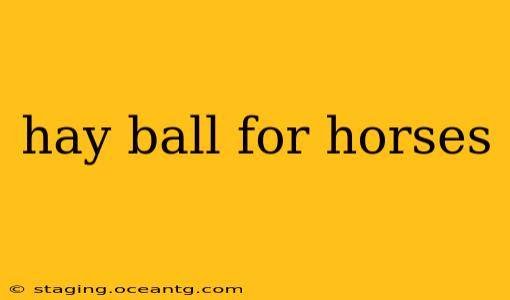Hay is a cornerstone of a horse's diet, providing essential fiber and nutrients. However, simply tossing hay into a field or stall isn't always the most efficient or beneficial method. Hay balls, also known as hay nets or slow feeders, offer a variety of advantages, making them a popular choice for horse owners. This comprehensive guide explores everything you need to know about hay balls for horses, addressing common questions and concerns.
What are Hay Balls for Horses?
Hay balls are devices designed to dispense hay slowly to horses. They come in various shapes and sizes, from simple nets to more complex, durable designs. The primary purpose is to encourage slower eating, mimicking the natural grazing behavior of horses in the wild. This method reduces the risk of several health problems associated with fast eating, such as colic and ulcers.
What are the Benefits of Using Hay Balls?
The benefits of using hay balls for your horse are numerous:
-
Slower Eating: This is the biggest advantage. Slowing down a horse's eating helps prevent them from gulping down large quantities of hay, reducing the risk of digestive upset.
-
Improved Digestion: Slower eating aids in better digestion, leading to more efficient nutrient absorption.
-
Reduced Colic Risk: Colic, a serious and often fatal condition, can be triggered by rapid consumption of large amounts of hay. Hay balls significantly mitigate this risk.
-
Weight Management: Slower eating can be beneficial for horses prone to obesity. The controlled release of hay helps them feel full for longer, preventing overeating.
-
Dental Health: The act of pulling hay from a net or ball provides some natural dental stimulation.
What Types of Hay Balls are Available?
The market offers a wide array of hay balls, catering to different needs and budgets:
-
Simple Mesh Nets: These are the most basic and affordable option. They’re easy to fill and clean, but may not be as durable as other choices.
-
Heavy-Duty Nets: Made from stronger materials, these nets are more resistant to tearing and chewing, lasting longer than simple mesh nets.
-
Slow Feed Hay Balls: These are designed with smaller openings or more complex structures, further slowing down the eating process.
-
Hay Bags: Similar to nets, but often made from a more robust fabric. They're often larger and can hold significant quantities of hay.
How do I Choose the Right Hay Ball for My Horse?
Selecting the appropriate hay ball depends on several factors:
-
Your Horse's Eating Habits: A horse that tends to bolt its food may benefit from a slow-feed design.
-
Hay Type: The size and type of hay will influence the appropriate size and type of hay ball. Larger hay pieces may require larger openings.
-
Horse's Size and Breed: A larger horse will generally need a larger hay ball to provide adequate feed for a sufficient period.
-
Durability: Consider the horse's chewing habits. A horse that is a vigorous chewer will need a more durable hay ball.
Are There Any Disadvantages to Using Hay Balls?
While generally beneficial, hay balls have some potential drawbacks:
-
Potential for Choking: If the hay is densely packed or the mesh is too small, there is a small risk of your horse choking. Regular monitoring is essential.
-
Cost: High-quality, durable hay balls can be more expensive than simple mesh nets.
-
Cleaning: Regular cleaning is necessary to prevent mold and mildew growth.
How Often Should I Change the Hay in a Hay Ball?
This depends on the size of the hay ball and your horse's eating habits. Generally, it’s recommended to refill hay balls once or twice a day to ensure a consistent supply of fresh hay.
How do I Clean a Hay Ball?
Regular cleaning is crucial. Remove the remaining hay and wash the hay ball thoroughly with soap and water, allowing it to air dry completely before refilling.
By carefully considering the factors outlined above, you can choose and utilize hay balls effectively, contributing to the overall health and well-being of your equine companion. Remember to always supervise your horse while it is feeding from a hay ball.
